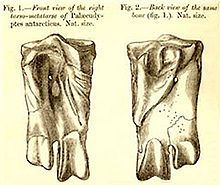Palaeeudyptes
| Palaeeudyptes Temporal range:
| |
|---|---|

| |
| Huxley’s original illustration of the fossil of an ankle bone from Palaeeudyptes antarcticus described in 1859. | |
| Scientific classification | |
| Domain: | Eukaryota |
| Kingdom: | Animalia |
| Phylum: | Chordata |
| Class: | Aves |
| Order: | Sphenisciformes |
| Family: | Spheniscidae |
| Subfamily: | †Palaeeudyptinae |
| Genus: | †Palaeeudyptes Huxley, 1859[1] |
| Type species | |
| Palaeeudyptes antarcticus Huxley, 1859
| |
| Species | |
|
Palaeeudyptes antarcticus | |
| Synonyms | |
Palaeeudyptes is an
extinct genus of large penguins, currently containing four accepted species. They were probably larger than almost all living penguins, with the smaller species being about the size of an emperor penguin, and the largest species, Palaeeudyptes klekowskii, having stood up to 2 meters (6.6 ft) tall and weighed up to 116 kg (256 lb).[3]
Known species
Of the four species, two (P. gunnari and P. klekowskii) are known from numerous remains found in Middle or Late
Burnside, Dunedin. To this species also a number of additional remains have been tentatively assigned. The problem with the indeterminate New Zealand specimens is that they at least in part are intermediate in size between the two species.[4] It may be that P. marplesi simply evolved into the smaller P. antarcticus. Bones unassignable to species also were found on Seymour Island, but in these cases they seem to be from juvenile individuals or are simply too damaged to be of diagnostic value.[5]
In addition, an incomplete right
Witton Bluff near Adelaide, Australia.[6][4] Additionally, an incomplete humerus identified as Palaeeudyptes was recovered in southernmost Chile,[7] from middle to late Eocene beds of the Río Turbio Formation, near Puerto Natales, 200 km (120 mi) south from Torres del Paine National Park.[citation needed
]
Phylogeny
The supposed genus synonym of P. gunnari.[5]
The genus is the namesake for the subfamily of primitive penguins, Palaeeudyptinae. Altogether, their osteological characteristics seem to have been somewhat less advanced that those of the slightly smaller Archaeospheniscus and about on par with the gigantic Anthropornis. The exact nature of the relationship of the Palaeeudyptinae to modern penguins is unknown.[citation needed]
See also
- Kairuku, a genus historically referred to as Palaeeudyptes
References
- S2CID 130362530.
- S2CID 84900109.
- hdl:11336/32571.
- ^ a b Simpson, George Gaylord (23 June 1971). "A review of the pre-Pleistocene penguins of New Zealand" (PDF). Bulletin of the American Museum of Natural History. 144: 319–378. Archived from the original (PDF) on 11 August 2007.
- ^ a b Jadwiszczak, Piotr (2006). "Eocene penguins of Seymour Island, Antarctica: Taxonomy" (PDF). Polish Polar Research. 27 (1): 3–62. Archived from the original (PDF) on 24 July 2007.
- ^ Simpson, George Gaylord (8 August 1946). "Fossil Penguins" (PDF). Bulletin of the American Museum of Natural History. 87: 7–99. Archived from the original (PDF) on 21 February 2007.
- .
